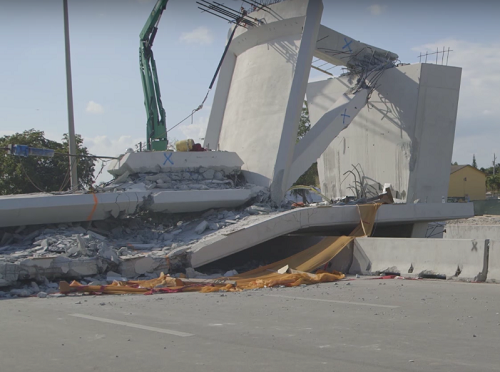FIU Bridge Collapse Documents Released
FRIDAY, OCTOBER 11, 2019
As part of the ongoing investigation into the bridge collapse at Florida International University that occurred more than a year ago, the National Transportation Safety Board recently released 6,300 pages of documentation detailing its examination of contractors on the project. One engineer reportedly claimed that the highway underneath the bridge should have been closed while the project was ongoing.
According to the Miami Herald, Will Watts, the chief engineer for the Florida Department of Transportation, said in a letter to the NTSB that both FIU and its contractor were responsible for requesting that Tamiami Trail be closed during construction. That request was never made, however. (Watts’ letter was also part of the documentation released.)
FIU Bridge Collapse
FIU is home to the Accelerated Bridge Construction University Transportation Center, a multi-university center promoting ABC techniques. The pedestrian bridge was touted as an example of innovative design and construction meant to limit road closures and inconvenience stemming from the otherwise lengthy bridge construction process.

 |
| National Transportation Safety Board, public domain, via Wikimedia Commons |
|
As part of the ongoing investigation into the bridge collapse at Florida International University that occurred over a year ago, the National Transportation Safety Board recently released 6,300 pages of documentation detailing its examination of contractors on the project. One engineer reportedly claimed that the highway underneath the bridge should have been closed while the project was ongoing. |
According to CNN, shortly after the span was installed, W. Denney Pate, employed with FIGG, which was part of the design-construction team, noticed there was an issue—a crack had formed along the north side of the bridge, and repairs were needed.
In early May 2018, the Herald sued after two months of attempts to access documents related to the collapse, and in early June, FDOT asked a County Circuit Court judge to dismiss the suit. The newspaper said the agency acknowledged that the records fell under the state’s open-records law, but FDOT argued that its pertinence to the NTSB's investigation meant they could not be released publicly.
In August, Leon County state court Judge Kevin Carroll ruled that FDOT must release the records associated with the tragedy. A federal judge, though, quickly stepped in and blocked the release of the documents. In September, a preliminary report from the NTSB indicated that cracks found in the bridge a few days before it collapsed were much more extensive than originally thought.
In April, after MCM filed for bankruptcy, lawyers presented documents alleging that engineers dismissed cracks found in the bridge prior to the disaster. The following month, the construction company responsible for building the FIU bridge reached an agreement with insurers to pay up to $42 million to victims of the incident, as well as their families.
In June, in the 115-page report, federal work-safety investigators determined that the street that ran under the bridge should have been shut down because of cracks in the structure. Parties involved failed to recognize the danger due to design errors. Later that same month, the project’s lead technical designer testified during a pretrial hearing regarding evidence. This was the first time he had commented since the tragedy. In August, companies being sued in light of the incident decided to settle, though one last holdout could delay the disbursement of funds to incident victims.
Recent NTSB Report
In the wake of the recently released report, the NTSB will have a probable cause hearing regarding the collapse, as well as issue safety recommendations on Oct. 22, in Washington, D.C. In light of the recently released documentation, however, FDOT, FIGG and MCM recently defended their actions to the NTSB, along with blaming others. Since the probe is still ongoing, those comments cannot be made public.
Among the measures FDOT has reportedly taken, the state transportation department has improved the way it oversees such construction work, along with being more actively involved. FIGG has also since voiced its contention with reports of errors in the bridge design, along with creating the website flbridgefacts.com.
FIGG also detailed that it had hired forensic structural engineering experts Wiss, Janney, Elstner Associates to conduct an investigation, which revealed that the construction joints at the failure point were not roughened in alignment with Florida standards. (Roughening would have also contributed to the strength of the connection.)
Another report, by the Turner-Fairbank Highway Research Center, for the Federal Highway Administration, indicated similar results regarding roughening. The FHWA does not pinpoint the cause of the collapse on this, however.
Additionally, FDOT also now requires that agencies and project-relevant entities close down state infrastructure such as roads and bridges when circumstances could pose a risk to the public. More complex projects will also call for an FDOT manager will focus on facilitating communication as well as increase the department’s involvement.
Louis Berger Group was also erroneously listed as pre-qualified for an evaluation to be carried out on the bridge. FDOT special counsel Latasha Johnson also wrote in an email to the NTSB that Berger should have known whether it was qualified for this kind of work.
Tagged categories: Accelerated Bridge Construction (ABC); Bridges; Bridges; Health & Safety; Infrastructure; NTSB (National Transportation Safety Board); Project Management



